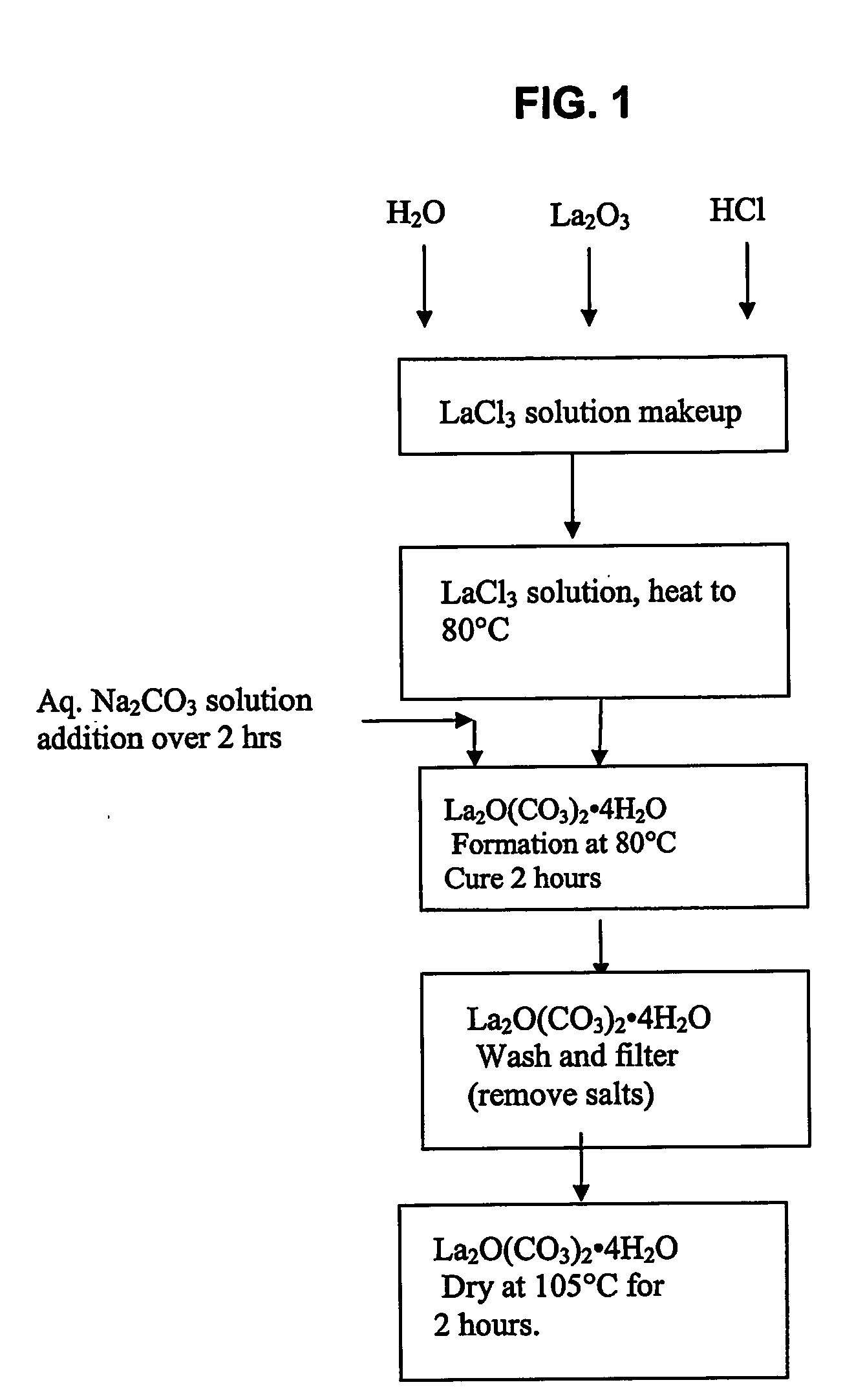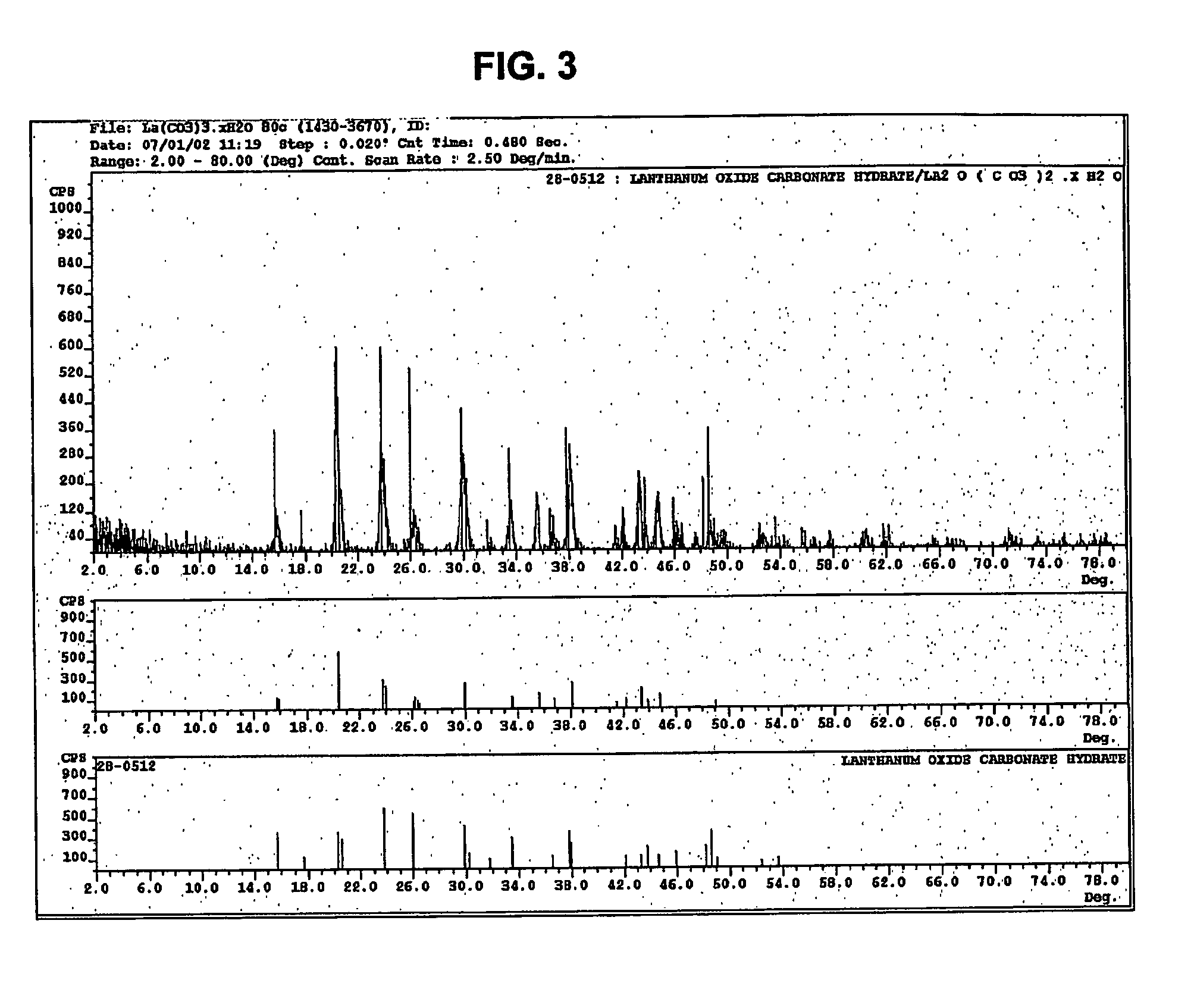Rare earth compositions and structures for removing phosphates from water
a technology of rare earth compositions and structures, applied in the nature of treatment water, biocide, filtration treatment, etc., can solve the problems of lanthanum carbonate reaction being typically slow, requiring substantial amounts of toxic chemicals, and requiring several days
- Summary
- Abstract
- Description
- Claims
- Application Information
AI Technical Summary
Benefits of technology
Problems solved by technology
Method used
Image
Examples
example i
[0027] An aqueous solution having a volume of 335 ml and containing lanthanum chloride (LaCl3) at a concentration of 29.2 weight % as La2O3 was added to a 4-liter beaker and heated to 80° C. with stirring. The initial pH of the LaCl3 solution was 2.2. A volume of 265 ml of an aqueous solution containing 63.6 g of sodium carbonate (Na2CO3) was metered into the heated beaker using a small pump at a steady flow rate for 2 h. Using a Buchner filter apparatus fitted with filter paper, the filtrate was separated from the white powder product. The filter cake was mixed 4 times with 2 liters of distilled water and filtered to wash away the NaCl formed during the reaction. The washed filter cake was placed into a convection oven set at 105° C. for 2 h or until a stable weight was observed. FIG. 2 shows a scanning electron micrograph of the product, enlarged 120,000 times. The X-Ray diffraction pattern of the product (FIG. 3) shows that it consists of hydrated lanthanum oxycarbonate La2O(CO3)...
example ii
[0030] An aqueous solution having a volume of 335 ml and containing lanthanum chloride (LaCl3) at a concentration of 29.2 weight % as La2O3 was added to a 4-liter beaker and heated to 80° C. with stirring. The initial pH of the LaCl3 solution was 2.2. A volume of 265 ml of an aqueous solution containing 63.6 g of sodium carbonate (Na2CO3) was metered into the heated beaker using a small pump at a steady flow rate for 2 h. Using a Buchner filter apparatus fitted with filter paper, the filtrate was separated from the white powder product. The filter cake was mixed 4 times with 2 liters of distilled water and filtered to wash away the NaCl formed during the reaction. The washed filter cake was placed into a convection oven set at 105° C. for 2 h or until a stable weight was observed. Finally, the lanthanum oxycarbonate was placed in an alumina tray in a muffle furnace. The furnace temperature was ramped to 500° C. and held at that temperature for 3 h. The resultant product was determin...
example iii
[0039] A solution containing 100 g / l of La as lanthanum acetate is injected in a spray dryer with an outlet temperature of 250° C. The intermediate product corresponding to the spray-drying step is recovered in a bag filter. This intermediate product is calcined at 600° C. for 4 h. FIG. 8 shows a scanning electron micrograph of the product, enlarged 60,000 times. The X-Ray diffraction pattern of the product (FIG. 9) shows that it consists of anhydrous lanthanum oxycarbonate La2CO5. The surface area of the sample, measured by the BET method, was 25 m2 / g.
PUM
| Property | Measurement | Unit |
|---|---|---|
| size | aaaaa | aaaaa |
| temperature | aaaaa | aaaaa |
| size | aaaaa | aaaaa |
Abstract
Description
Claims
Application Information
 Login to View More
Login to View More - R&D
- Intellectual Property
- Life Sciences
- Materials
- Tech Scout
- Unparalleled Data Quality
- Higher Quality Content
- 60% Fewer Hallucinations
Browse by: Latest US Patents, China's latest patents, Technical Efficacy Thesaurus, Application Domain, Technology Topic, Popular Technical Reports.
© 2025 PatSnap. All rights reserved.Legal|Privacy policy|Modern Slavery Act Transparency Statement|Sitemap|About US| Contact US: help@patsnap.com



